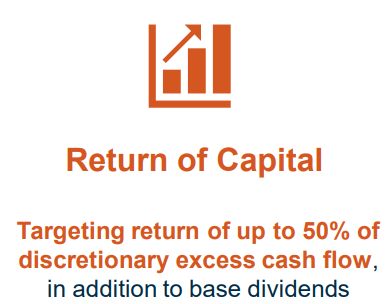imaginima
Investment Thesis
Crescent Point Energy (NYSE:CPG) is very cheaply valued relative to its near-term potential, even if the stock promises to remain volatile over time.
Let’s discuss the most important consideration first. The bullish investment thesis here is one of large capital returns to shareholders.
CPG contends that 50% of its excess cash flow, which for CPG means free cash flow after dividends, will be coming back to shareholders via share repurchases.
While its earnings call makes a passing mention of a special dividend potentially being on the cards, I have not put any weight on that comment.
This implies that front and center, total shareholder returns will be approximately 10.9% via buybacks, plus 3.1% via dividends. A total of 14% total shareholder returns (more on the math in the analysis that follows).
The bear case is that nobody can predict oil prices. And that’s why the stock is cheap.
Ultimately, I believe that embracing some volatility while being on the cards for a double-digit capital return is better than other pockets of the market.
In other pockets of the market, one is getting just the same level of volatility but with no capital return anywhere in sight.
What’s Going On?
At first, many investors were super bullish on oil and gas companies. Then, it appeared that tech was making a comeback, and investors couldn’t wait to leave the land of “unpromising” returns found in oil and gas stocks, to go back to investing their capital into “asset-light companies” with colorful narratives and little else to back their vision.
Then, once again, the market appears to have changed course. Most recently, there appears to have been an about-turn as investors flock away from tech names and move to the sidelines.
Meanwhile, amidst all this moving around of capital, Crescent Point Energy continues to positively tick along and has some mightily attractive prospects.
The Biggest Uncertainty: How Does 2023 Look to Shape Up?
Adding insult to injury, we were told that in a recession, demand for oil would rapidly sap, leading to oil prices tumbling down. This led investors to exit this space en masse, with CPG today down more than 20% from the peaks reached in early June.
But despite the uncertainty of whether we are facing an imminent recession or not, the fact remains that oil prices remain ebullient.
In fact, as I write, oil prices are still nicely above $90 WTI. This appears to defy the bear case about oil prices.
Could it be that we are more dependent on oil than analysts previously expected? Perhaps, we are still an oil economy?
Now, at the start of this year many investors made the claim that 2022 would mark the high point for WTI and that 2023 would rapidly see WTI prices return lower.
Today, I’m not so sure that investors can with such ease make the claim that in 2023 oil returns lower.
In fact, I declare that we are likely to see much of the same in oil prices as right now. At least I believe that it’s possible that oil prices remain well above $80 WTI.
After all, consider this. Even analysts that are making the assertion that we are about to enter a recession, of those analysts I have not heard any of them, even the most bearish, making the argument that the US is about to enter a severe recession. Most analysts believe that a mild recession is more likely.
Further, recall that throughout much of 2022, China has been in and out of lockdown. Altogether, this has been a headwind for oil prices in 2022. And now, this is more likely than not to turn into a tailwind in 2023.
On yet another hand, the big unknown remains. Do Russian sanctions get dealt with at some point soon? Does everyone really return to being “friends” once again after everything that’s happened in 2022? Can politicians really see a way to lift sanctions and save face? I’m not too sure that’s a likely outcome for 2023.
Crescent Point’s Capital Return Framework, A Load of Buybacks
CPG, like many Canadian oil producers, has attempted to assuage investors that it will not squander its excess free cash flows.
CPG Q2 2022 Presentation
CPG makes the case that it will return 50% of its free cash flows. And since CPG is an oil company, this excess free cash flow is after its dividend is taken out already.
Consequently, looking ahead to Q3, CPG is now returning 50% of its free cash flow back to shareholders via share repurchases.
Note, what CPG terms excess free cash flows means after the dividend is paid out, 50% of that free cash flow will return to shareholders.
CPG Valuation – 14% Combined Yield
In the first instance, let’s focus on CPG’s hedged book. During the recent earnings call, CPG said,
[W]e have hedged approximately 20% to 25% of our production during the first half of 2023, which is down from the approximately 50% of our production hedged during 2022.
Consequently, I believe that this implies that at the high end of current estimates, CPG will hedge its production by around 25%. This implies that relative to 2022, CPG will be substantially more exposed to WTI prices than it was in 2022.
With that in mind, let’s discuss 2023 WTI prices.
Honestly, to assume that oil prices stay at $90 WTI is a heroic assumption. There are so many moving macro considerations that make that assumption borderline reckless. But we must start our assumptions somewhere.
Along these lines, CPG asserted that with WTI around $100, CPG would make around C$1.4 billion free cash flow after dividends. Hence, if we were to assume that WTI stays around $90, we could probably see around C$1.2 billion of free cash flow after dividends over the next twelve months.
Consequently, we would see approximately C$600 million returning to shareholders over the next twelve months, or a 10.9% return.
Then, as you know already, investors would get a 3.1% dividend on top of that too!
This means that at current prices, my base case scenario sees around 14% combined yield.
The Bottom Line
A lot of investors believe that they have already missed out on the gains that the oil market has to offer.
And while it’s super easy to look in hindsight and make off-the-cuff proclamations of what could have been, the fact remains clear that looking ahead, this looks attractive.
In fact, investors getting in today are going to be on the cards for a 14% combined yield. And this makes no mention of any potential share price appreciation that would likely come into effect over time.
With a stock priced at less than 5x free cash flow, it’s difficult to argue that this expensive valuation, particularly compared to other pockets of the market.


Be the first to comment